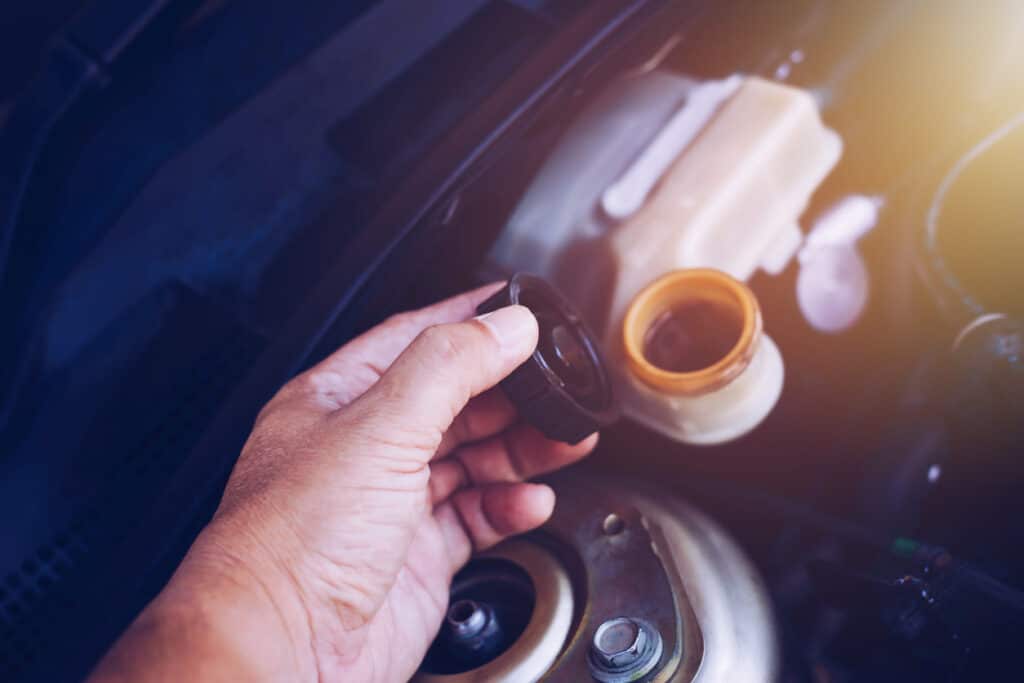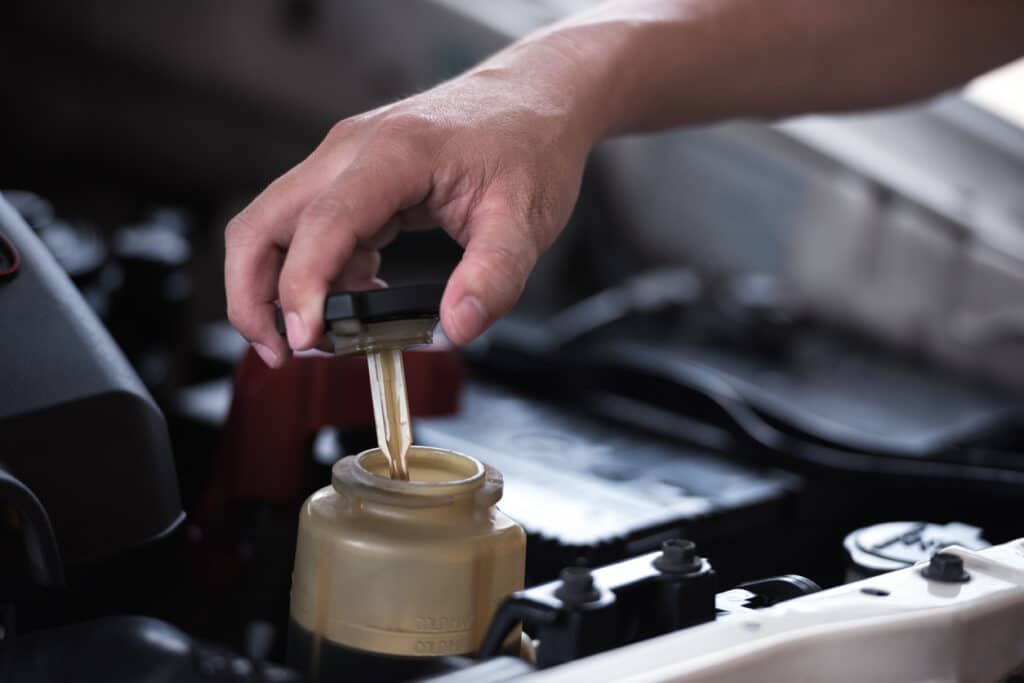Power steering fluid has an important role to play in maintaining safe handling while making sure your car is easy to manoeuvre at low speed. So if it leaks it’s bad news for your car, your driving experience and your wallet.
The good news is power steering leaks aren’t all that common, particularly on newer, modern cars. But when leaks do occur they normally start small before getting worse. They can also be difficult to spot and diagnose.
If you suspect a power steering leak could be behind recent handling problems, our guide can help you spot the problem and work out the most likely cause. We’ve covered everything you need to know about power steering fluid, including the signs of a leak and how to check and top up your power steering fluid reservoir should you need to.
Use the links below to find the help you need or read on for the full guide.
Quick Links
- What Does Power Steering Fluid Do?
- Signs of a Power Steering Fluid Leak
- Causes of a Power Steering Fluid Leak
- What to Do if You Find a Power Steering Leak
- How to Check and Top Up Power Steering Fluid
What Does Power Steering Fluid Do?
Power steering fluid is a type of hydraulic fluid that’s used to transfer energy from the steering wheel to the wheels. It essentially forms a hydraulic link between different parts of the steering system, with the purpose being to make it easier to turn the wheels – particularly during low-speed manoeuvres.
If you’ve ever driven a car without power steering, you’ll know how much work is required to get the wheels turning at low speed. To compensate for this, power steering fluid creates hydraulic pressure within the steering system, ensuring that components like the gears and pumps continue to work smoothly and easily, even when the wheels aren’t turning at a fast speed.
The result is light, responsive handling that requires little to no effort from the driver. Indeed since power steering was first introduced, it’s become an indispensable system on all modern cars and larger vehicles, making steering much easier to manage in all driving conditions.
As well as aiding handling, power steering fluid also lubricates and maintains internal components within the steering system. Should fluid escape and the problem go undetected, increased friction within the system could result in long-term damage and premature wear.
Signs of a Power Steering Fluid Leak
If you’ve noticed a change in how your car handles, a power steering fluid leak could be to blame. But since lots of problems can impact steering performance – including faults with the suspension, brakes and tyres – you need to know what the signs of a power steering fluid leak are so you can diagnose the issue properly.
Below we look at some of the typical symptoms of a power steering fluid leak:
- High-pitched noise when turning your car’s ignition on
- Grinding or whining noise when turning the wheel
- Stiffness in the steering wheel that may come and go
- A ‘check power steering’ warning light on the dashboard
- Low power steering fluid level on the reservoir
- Droplets of fluid below the engine on the floor
Causes of a Power Steering Fluid Leak
If your handling issue does turn out to be a power steering fluid leak, there are a number of possible causes. While we’d always recommend taking your car to a professional if you suspect a leaky power steering system, it’s good to know the potential problems which include:
- Worn seal on power steering pump
- Cracked, perished or loose power steering fluid hose
- Excessive pressure in power steering system caused by an overfilled reservoir, which could result in blown seals
- Wear and tear in power steering rack, particularly the shaft ends and seals
- Dried and cracked seals in the system lose their flexibility, leading to degradation and corrosion

As mentioned earlier, power steering fluid leaks can be tricky to identify and diagnose, so our advice would always be to seek professional help as soon as you notice a problem with your car’s steering. Also never ignore a problem that concerns how your car handles, as power steering fluid leaks can cause dangerous variance in steering performance if left untreated.
What to Do if You Find a Power Steering Leak
If you’ve noticed a leak in your power steering system, in most cases a repair will be required to fix the problem at the source. Since most leaks are caused by gradual degradation and the corrosion of internal parts, replacing components like seals and pumps may be needed to seal the system and ensure it’s working optimally.
As soon as you notice a problem with your car’s steering and handling, book it in to get checked at a garage right away. If the problem is diagnosed and dealt with quickly, it could be much easier and cheaper to repair.
How to Check and Top Up Power Steering Fluid
Since power steering fluid leaks aren’t that common, many drivers forget to check their car’s power steering fluid level as part of their regular maintenance regime. But it’s important to check the fluid level in the reservoir often to spot the early signs of a leak and make sure your steering system is in peak condition.
Below we’ll take you through the process of checking and topping up your car’s power steering fluid step by step.
Checking the Power Steering Fluid Level
- Make sure the engine is completely cool before checking the power steering fluid.
- Locate the power steering fluid reservoir under the bonnet. The cap will be labelled with a small icon of a steering wheel. Your car’s manual should be able to help you find the reservoir if you’re unsure.
- Most cars have either a clear power steering fluid reservoir, whereby you read the level against the ‘min’ and ‘max’ markers on the side of the tank, or a dipstick-type wherein you read the level on a rod attached to the cap. Either way, the level should be close or at the ‘max’ marker to guarantee optimal steering performance and protection.
Topping Up Your Car’s Power Steering Fluid
- If your car’s power steering fluid reservoir needs topping up, make sure to use a high-quality power steering fluid that’s compatible with your car’s engine. Since power steering fluid comes in different viscosities, it’s important to use the one that’s recommended for your car; your manual can advise on the fluid to use.
- Topping up your car’s power steering fluid should be done slowly and in small amounts, so you can continuously check the level and make sure it’s not over the ‘max’ fill line. Remember, overfilling the system can result in blown seals, so proceed slowly and carefully until you reach the required level.
- When the reservoir is topped up, make sure you replace the cap tightly before closing the bonnet.
Tip – if you suspect a leak, check your car’s power steering fluid reservoir after every journey to see if the level has changed. This is a fool-proof way to definitively find out if the system is leaking.
Have you found this guide useful? Head to the Prestone help centre for more tips and advice. Or if you’re looking for recommendations on the best fluid to use in your car, find out more about high-performance Prestone Power Steering Fluid.



